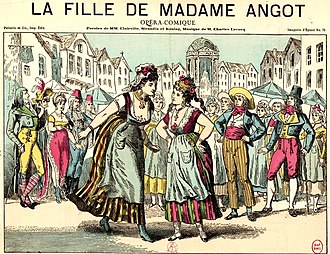
La fille de Madame Angot (Madame Angot's Daughter) is an opéra comique in three acts by Charles Lecocq with words by Clairville, Paul Siraudin and Victor Koning. It was premiered in Brussels in December 1872 and soon became a success in Paris, London, New York and across continental Europe. Along with Robert Planquette's Les cloches de Corneville, La fille de Madame Angot was the most successful work of the French-language musical theatre in the last three decades of the 19th century, and outperformed other noted international hits such as H.M.S. Pinafore and Die Fledermaus.
The opera depicts the romantic exploits of Clairette, a young Parisian florist, engaged to one man but in love with another, and up against a richer and more powerful rival for the latter's attentions. Unlike some more risqué French comic operas of the era, the plot of La fille de Madame Angot proved exportable to more strait-laced countries without the need for extensive rewriting, and Lecocq's score was received with enthusiasm wherever it was played.
Although few other works by Lecocq have remained in the general operatic repertory, La fille de Madame Angot is still revived from time to time.